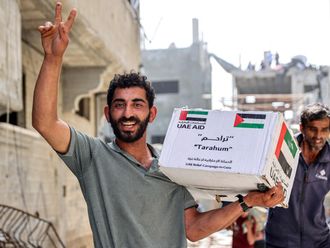Tripoli: A summary of the main political and armed groups in Libya, which has plunged into anarchy since the 2011 uprising that toppled and killed Muammar Gaddafi.
General National Congress
The GNC or parliament, Libya’s highest political authority, comprises 200 members elected in July 2012. Dominated by Islamists and criticised for giving Islamist militias legitimacy by giving them security tasks.
The government
A victim of GNC political wrangling, the government regularly complains about its lack of powers, particularly in security matters.
Former premier Ali Zaidan who tried to stand up to the GNC was ousted in March and was replaced by Abdullah Al Thani, who resigned a few weeks later. In early May the GNC elected a new premier, Ahmad Miitig, who was due to present his cabinet for approval this week.
The national army
Still being trained, but heavily outgunned by former rebel groups that raided the arsenals of the Gaddafi regime. Some groups have joined the army’s ranks but retain their own commanders and look after their own interests.
Armed groups in Benghazi
The “National Army”: A paramilitary force created by retired former general Khalifa Haftar that on Friday attacked Islamist militias to eradicate “terrorism”. Several officers based in the east, including from the air force, have joined him.
Authorities in Tripoli accuse it of trying to mount a coup.
Special forces: Elite units of Libya’s regular army, regularly targeted by attacks blamed on extremists, have backed Haftar’s operations.
February 17 Martyrs and Rafallah Al Sahati Brigades: Two powerful militias “officially” under defence ministry control and tasked with several missions, particularly in the south.
Ansar Al Sharia Brigades: Classified by Washington as a terrorist organisation, this group is suspected of involvement in targeting officers and soldiers, and in the September 2012 attack on the US consulate that killed US ambassador Chris Stevens and three other Americans.
Ansar Al Sharia also has branches in the eastern town of Derna, Sirte in central Libya and Sabratha in the west.
Cyrenaica force: Formed by supporters of a federal government who want autonomy for eastern Libya. Includes guards from petroleum installations who have blockaded oil terminals.
Armed groups around Tripoli
Zintan’s Al Qaaqaa and Al Sawaiq brigades: Formed in the western town of Zintan, these are well established in the capital, controlling the airport and several military sites, and are seen as among the best armed and disciplined.
Hostile to Islamist groups, they are considered by their rivals as the armed wing of the liberal movement.
Officially under defence ministry control, they claimed a May 18 attack on the GNC, demanding its dissolution.
Operations Cell of Libyan Revolutionaries and Libya Shield Force: Comprised of several Islamist militias considered to be the armed wing of Islamist groups within the GNC.
Misrata militias: Like their rivals from Zintan, groups from the coastal town of Misrata are seen as being among the best armed and most powerful.
Some have joined other groups, like Libya Shield Force or the Operations Cell of Libyan Revolutionaries, but often in the best interests of their hometown.
Unlike Zintan groups, they defend the GNC’s legitimacy.












